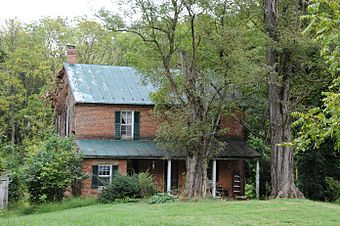Whittaker Chambers Farm facts for kids
|
Whittaker Chambers Farm
|
|
 |
|
| Location | East Saw Mill Rd., Westminster, Maryland |
|---|---|
| Area | 390 acres (160 ha) |
| Built | 1941 |
| NRHP reference No. | 88001824 |
Quick facts for kids Significant dates |
|
| Added to NRHP | May 17, 1988 |
| Designated NHLD | May 17, 1988 |
The Whittaker Chambers Farm, also called the Pipe Creek Farm, is a historic group of farm properties. It is located near Westminster, Maryland in rural Carroll County, Maryland. This farm is important because it was owned by Whittaker Chambers (1901-1961). He was a key figure in American politics during the Cold War.
In December 1948, Chambers hid some important papers here. These papers, called the "Pumpkin Papers," were on tiny film (microfilm). He hid them while waiting to share information with a government committee. Chambers also wrote his famous book, Witness, at this farm in 1952. The farm was named a National Historic Landmark in 1988. This was a bit unusual at the time. The property is still owned by the Chambers family and is not open to visitors.
Contents
About the Whittaker Chambers Farm
The Whittaker Chambers Farm is located a few miles north of Westminster. It is bordered by East Saw Mill Road and Pipe Creek. The farm is made up of three areas bought at different times. Together, they cover about 390 acres (158 hectares).
The land has both open fields for farming and woods. Whittaker Chambers ran this farm as a dairy farm. He called it a "dirt farm."
Parts of the Farm
- The first part of the farm was 40 acres (16 hectares). Chambers bought this land in 1941. He lived here starting that year. After a fire in 1957, he sold it. The family later bought it back. The original barn burned down in 2007. Other buildings from Chambers' time are still there. The spot where the "Pumpkin Papers" were hidden is no longer a strawberry patch.
- The second part, called the Pipe Creek Farm, is about 230 acres (93 hectares). Chambers bought this in 1946, and it is still owned by his family. The house on this property was built in the mid-1800s. Chambers lived here from 1957 until he passed away in 1961. This part of the farm also has a pond and other small buildings.
- A third part of 120 acres (49 hectares) connects the first two areas. Chambers bought this in 1947. The house on this land is known as "Medfield." It was built in the 1800s. Chambers used it as a quiet place to write. In the 1950s, he added a connection between the main house and a nearby summer house. This property also remains with the Chambers family. In 2010, the Medfield farmhouse caught fire due to an electrical problem.
Why the Farm is Historic
Whittaker Chambers joined the Communist Party in 1925. He started sharing secret information for the Soviet Union in 1932. By 1937, he began to disagree with the party. He left it by 1938.
In 1948, Chambers was asked to testify about a group that was spying. This group included Alger Hiss. Hiss was an official in the State Department in the 1930s. Hiss was later found guilty of perjury (lying under oath) in two famous trials. These trials were big events at the start of the Cold War.
In December 1948, Chambers hid and then got back microfilm from a hollowed-out pumpkin on his farm. He gave this microfilm to investigators. This led directly to Hiss being charged. The case also made Richard Nixon, who was a little-known Congressman from California at the time, very famous.
The farm was also important in the story of Chambers and Hiss. Chambers said he first saw a nearby property with Hiss. Hiss had planned to buy it. In 1937, Chambers bought that property instead. He then started buying what became the Pipe Creek Farm. This was his safe place away from his past life. He moved his family there in 1941.
National Landmark Status
The decision to make the Chambers Farm a National Historic Landmark in 1988 was unusual. Usually, a place needs to be at least 50 years old to be considered historic. This farm was not that old based on the events it was famous for. Also, the National Park Service Advisory Board did not recommend it. However, in May 1988, the Interior Secretary, Donald P. Hodel, still gave the Pipe Creek Farm national landmark status.
In 2012, a book about the Cold War questioned if the farm should be a landmark. One reason was that it is not open to the public. A member of the Chambers family explained that the farm is not a museum. It is a working farm, and that is why it is not open to visitors.
There have been plans to build a Union Mills Reservoir nearby. If built, this reservoir would flood parts of the Chambers property. Whittaker Chambers' son is against this project. He has bought back parts of the farm to put it back together. He told the Baltimore Sun: "This is where my parents died... My end-of-life goal has been to reassemble it and make it available to the next generation as a farm."



